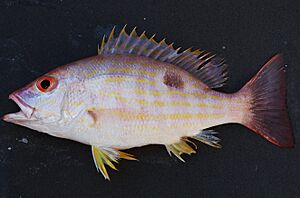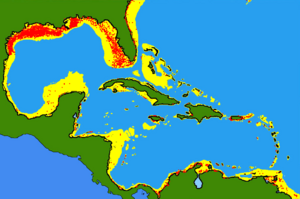Lane snapper facts for kids
Quick facts for kids Lane snapper |
|
|---|---|
 |
|
| Conservation status | |
| Scientific classification | |
 |
|
| Synonyms | |
The lane snapper (also called the Mexican snapper, redtail snapper, or spot snapper) is a type of fish found in the ocean. It's a ray-finned fish and belongs to the snapper family, called Lutjanidae. These fish live in the western part of the Atlantic Ocean.
Contents
About the Lane Snapper's Name
The lane snapper was first officially described in 1758. A famous scientist named Carolus Linnaeus gave it the name Sparus synagris. He thought this fish looked a lot like another fish called the common dentex. The word synagris is an old Greek name for that fish.
What Does a Lane Snapper Look Like?
The lane snapper has a body that is a bit flat from side to side and shaped like an oval. It has a pointy snout and a fairly large mouth. Inside its mouth, it has rows of sharp, cone-shaped teeth. Some of these teeth are larger, like small fangs.
Its fins are also special. It has a long fin on its back called the dorsal fin, which has 10 stiff spines and 12 to 13 soft rays. The fin on its underside, called the anal fin, has 3 spines and 8 to 9 soft rays. Its side fins (pectoral fins) are quite short. The tail fin is slightly forked.
Lane snappers can grow up to 60 centimeters (about 2 feet) long. But most of the time, they are around 25 centimeters (about 10 inches) long. The heaviest one ever recorded weighed about 3.5 kilograms (around 7.7 pounds).
These fish can change their colors slightly. Fish living in deeper water tend to be darker. In general, their upper body and back are pink to red, with a hint of green on their back. Their lower body and belly are silver with a yellow glow. They have yellow stripes on their head that go from their nose to their eye. On their sides, they have 8 to 10 yellow or pink stripes. They also have a faint black spot under the soft part of their dorsal fin. Their fins can be yellow or red.
Where Lane Snappers Live
Lane snappers live in the western Atlantic Ocean. You can find them as far north as North Carolina and Bermuda. They live south through the Gulf of Mexico and the Caribbean Sea, all the way down the coast of South America to Santa Catarina, Brazil.
They like to live near reefs and on sandy bottoms where there are sea plants like algae or sea grass. They can be found in waters from about 30 to 122 meters (100 to 400 feet) deep. Young lane snappers prefer to live in calm, shallow waters closer to shore.
Lane Snapper Life and Habits
Adult lane snappers usually stay in one area, which is called their home range. They only leave this area when it's time to lay their eggs.
What Lane Snappers Eat
Lane snappers are hunters that eat many different kinds of animals. They usually hunt at night. They eat smaller fish, squid, snails, and crustaceans like shrimp and crabs.
Lane Snapper Reproduction
Lane snappers gather together in groups to lay their eggs. For example, near Cuba, these groups form from March to September, with the most activity in July and August. Near Puerto Rico, the busiest time for laying eggs is in May.
They release their eggs and sperm into the water, where they mix and become fertilized. The fertilized eggs float in the ocean currents and hatch after about 23 hours. The baby fish, called larvae, are very tiny and settle down when they are about 1 centimeter (less than half an inch) long.
Who Eats Lane Snappers?
Larger fish and sharks are some of the main predators that hunt and eat lane snappers.
Fishing and Protecting Lane Snappers
People like to catch lane snappers because their meat is white and tastes good. You can find their meat sold in markets, especially in Mexico. Lane snappers are often caught in shallower waters compared to other types of snappers, like yellowtail snapper or gray snapper. Larger lane snappers can be found in deeper waters, but they are not as common there.
Sometimes, eating lane snapper meat can cause a type of food poisoning called ciguatera. This happens if the fish has eaten certain tiny organisms that produce toxins.
Fishermen catch lane snappers using different methods. These include nets pulled from beaches or boats, traps, handlines (fishing with a line held by hand), and nets dragged along the bottom of the ocean. Young lane snappers often live where there are lots of shrimp, so they are sometimes caught by accident by shrimp fishing boats.
Unfortunately, the number of lane snappers has gone down a lot in many areas because too many are being caught. Because of this, a group called the IUCN has listed the lane snapper as "Near Threatened". This means they are worried about the future of this species.


